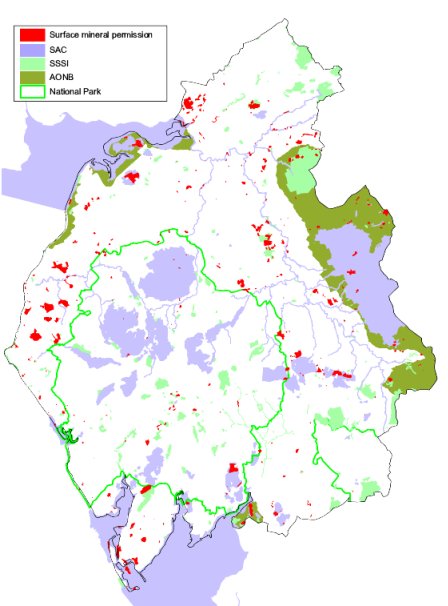Onshore mineral resource maps
Minerals are essential for the development of a modern economy, but their extraction is subject to environmental and other constraints. Bringing together minerals, environmental and other land-use information in an integrated system allows more effective and sustainable management strategies to be developed.
- mineral resource maps in England and parts of South Wales
- mineral resource maps in Northern Ireland
- mineral resource maps in Scotland
- mineral resource maps in Wales
- aggregates safeguarding maps in Wales
Mineral resource maps in England and parts of South Wales
The BGS was commissioned by the Office of the Deputy Prime Minister (now the Department for Levelling Up, Housing and Communities), through the research project 'Mineral resource information in support of national, regional and local planning', to prepare a series of 'county' mineral resource maps. This work was completed in early 2006 and a series of digitally generated maps at a scale of 1:100 000 are available. These maps cover 44 administrative areas or groups of administrative areas, giving information for the whole of England and parts of South Wales.
Four major elements of information are presented on the summary maps:
- the geological distribution of all onshore mineral resources
- the location of mineral extraction sites
- the extent of mineral planning permissions and licences for coal extraction
- the extent of selected landscape and nature-conservation designations (National Parks, AONBs, SSSIs, NNRs and scheduled monuments)
A primary objective was to produce baseline data in a consistent format that can be updated, revised and customised to suit planning needs, including for use in the preparation of mineral development plan documents and regional spatial strategies.
All the data on the 'county maps' has been merged to produce an online minerals information GIS for each English region. The maps and associated reports can be downloaded:
| County | Products | Date published | Reference number |
|---|---|---|---|
| Bedfordshire | 1995 | WF/95/2 | |
| Berkshire (comprising West Berkshire, Reading, Wokingham, Windsor and Maidenhead, Bracknell Forest and Slough) | 2004 | CR/03/074N | |
| Buckinghamshire and Milton Keynes | 2004 | CR/03/77N | |
| Cambridgeshire (comprising Cambridgeshire and the City of Peterborough) | 2003 | CR/02/131N | |
| Cheshire (comprising Cheshire, Boroughs of Halton and Warrington) | 2006 | CR/05/090N | |
| Cornwall | 1997 | WF/97/11 | |
| Cumbria and Lake District |
|
2001 | WF/01/02 |
| Derbyshire | 1995 | WF/95/3 | |
| Devon (comprising Devon, Plymouth, Torbay, Dartmoor National Park and part of Exmoor National Park) |
|
2006 | CR/05/096N |
| Dorset, Bournemouth and Poole | 2001 | WF/01/01 | |
| Durham and Tees Valley | 2000 | WF/00/6 | |
| East Sussex (comprising Brighton and Hove and East Sussex) | 2002 | CR/02/126N | |
| Essex (comprising Essex, Southend-on-Sea, Thurrock, London Boroughs of Barking and Dagenham, Havering, Redbridge and Waltham Forest) | 2002 | CR/02/127N | |
| Gloucestershire (comprising Gloucestershire and South Gloucestershire) | 2006 | CR/05/105N | |
| Greater Manchester (comprising Cities of Manchester and Salford and Metropolitan Boroughs of Bolton, Bury, Oldham, Rochdale, Stockport, Tameside, Trafford and Wigan) | 2006 | CR/05/182N | |
| Hampshire (comprising Hampshire, City of Portsmouth and City of Southampton) | 2003 | CR/02/129N | |
| Herefordshire and Worcestershire | 1999 | WF/99/4 | |
| Hertfordshire and north-west London boroughs | 2003 | CR/03/075/N | |
| Humberside (comprising East Riding of Yorkshire, North Lincolnshire, North East Lincolnshire and City of Kingston upon Hull) | 2005 | CR/04/227N | |
| Isle of Wight | 2002 | CR/02/130N | |
| Kent (comprising Kent, Medway and London Boroughs of Bexley and Bromley) | 2003 | CR/02/125N | |
| Lancashire (comprising Lancashire and Boroughs of Blackpool and Blackburn with Darwen) | 2006 | CR/05/144N | |
| Leicestershire, City of Leicester and Rutland | 2002 | CR/02/24/N | |
| Lincolnshire |
|
2003 | CR/02/128N |
| London boroughs |
|
2003 | |
| Merseyside (comprising City of Liverpool and Boroughs of Knowsley, Sefton, St Helens and Wirral) | 2005 | CR/05/129N | |
| Norfolk | 2004 | CR/03/174N | |
| North Yorkshire (comprising North Yorkshire, Yorkshire Dales and North York Moors National Parks and City of York) |
|
2006 | CR/04/228N |
| Northamptonshire | 2000 | WF/00/4 | |
| Northumberland and Tyne and Wear |
|
2000 | WF/00/5 |
| Nottinghamshire and City of Nottingham | 2002 | CR/02/23/N | |
| Oxfordshire | 2004 | CR/04/62N | |
| Peak District National Park | 1995 | WF/95/4 | |
| Shropshire |
|
1998 | WF/98/6 |
| Somerset (comprising Somerset, North Somerset, Bath & North East Somerset, City of Bristol and part of Exmoor National Park) | 2005 | CR/04/214N | |
| South Wales |
|
1997 | WF/97/10 |
| South Yorkshire (comprising Metropolitan Boroughs of Barnsley, Doncaster and Rotherham and City of Sheffield) | 2006 | CR/04/173N | |
| Staffordshire | 1995 | WF/95/5 | |
| Suffolk | 2003 | CR/03/076N | |
| Surrey (comprising Surrey and the London Boroughs of Croydon, Hounslow, Kingston upon Thames, Richmond upon Thames and Sutton) | 2003 | CR/03/073N | |
| Warwickshire | 1999 | WF/99/2 | |
| West Midlands | 1999 | WF/99/3 | |
| West Sussex | 1998 | WF/98/5 | |
| West Yorkshire (comprising Metropolitan Boroughs of Bradford, Calderdale, Kirklees and Wakefield and City of Leeds) | 2006 | CR/04/172N | |
| Wiltshire (comprising Wiltshire and the Borough of Swindon) | 2004 | CR/04/049N |
Mineral resource maps in Northern Ireland
Following a commission from the Department of the Environment, BGS and its counterpart the Geological Survey of Northern Ireland (GSNI) produced a mineral resources map of Northern Ireland. The map is intended to assist strategic decision making in respect of mineral extraction and the protection of important mineral resources against sterilisation. Six digitally generated maps at a scale of 1:100 000 scale are now available:
- County Antrim and Belfast
- County Armagh
- County Down and Belfast
- County Fermanagh
- County Londonderry
- County Tyrone
The map has been produced by the collation and interpretation of mineral resource data principally held by GSNI. The major elements of information presented on the map are:
- geological distribution of all onshore (above low water mark) mineral resources
- extent of mineral planning permissions and their current planning status (extant or expired)
- recorded occurrences of metallic minerals
- recorded location of building stone quarries
- extent of selected landscape and nature-conservation designations (SACs, SPAs, RAMSAR sites, AONBs, ASSIs, NNR and scheduled monuments) and planning designations (Area of Constraint on Mineral Developments)
Mineral resource maps in Scotland
BGS was awarded a grant from the Scottish Government Aggregates Levy Fund in 2007 to provide a comprehensive, relevant and accessible information base to enhance the sustainability of mineral resources for 18 local authorities in the central belt of Scotland. BGS co-funded this project through its Sustainable Mineral Solutions project. This work was completed in March 2008. A guide to minerals information in the central belt of Scotland and a series of found digitally generated maps at a scale of 1:100 000 are available:
- Mineral resource map for Clackmannanshire, Fife and Falkirk
- Mineral resource map for East Lothian, Midlothian, West Lothian and City of Edinburgh
- Mineral Resource map for North Ayrshire, East Ayrshire and South Ayrshire
- Mineral resource map for Inverclyde, West Dunbartonshire, East Dunbartonshire, Renfrewshire, East Renfrewshire, North Lanarkshire, South Lanarkshire and City of Glasgow
The maps show surface mineral resources, mineral working and the extent of selected national or international landscape and nature-onservation designations (National Parks, NSAs, SPAs, SACs SSSIs, NNRs, Ramsar sites and scheduled monuments).
Four major elements of information are presented on the summary maps:
- geological distribution of all onshore mineral resources
- location of mineral extraction sites
- extent of mineral planning permissions and licences for coal extraction
- extent of selected landscape and nature-conservation designations (National Parks, AONBs, SSSIs, NNRs and scheduled monuments)
Mineral resource maps in Wales
BGS was awarded a grant from the Welsh Government-administered Aggregates Levy Sustainability Fund for Wales in 2009 to provide a comprehensive, relevant and accessible information base to enhance the sustainability of mineral resources in Wales. BGS co-funded this project through its Sustainable Mineral Solutions team, part of the Minerals and Waste science programme. This work, which was led from the BGS Cardiff office, was completed in July 2010. The mineral resource maps of Wales and a series of six digitally generated maps at a scale of 1:100 000 are now available:
- south-east Wales
- south-west Wales
- north-east Wales
- north-west Wales
- mid-Wales (south)
- mid-Wales (north)
The major elements of minerals information presented on the maps are:
- geological distribution of all onshore (above low water mark) mineral resources in Wales
- location of mineral extraction sites
- recorded occurrences of metallic minerals
- recorded location of former slate quarries and significant areas of slate waste
- recorded location of historic building stone quarries
Aggregates safeguarding maps in Wales
As mineral resources are finite and not evenly distributed, knowledge about their whereabouts is essential for making effective and sustainable planning decisions that consider the needs of future generations. Access to mineral resources can be prevented or restricted (sterilised) by non-mineral development and the process of 'mineral safeguarding' ensures that this does not occur unnecessarily when planning applications are determined. An effective safeguarding system requires the adoption of 'mineral safeguarding areas' and the adoption of suitable policies through which development is managed in these areas.
The aggregates safeguarding maps have been compiled to assist mineral planning authorities (MPAs) in the delineation of aggregates safeguarding areas in local development plans. The aggregates safeguarding maps of Wales and a series of six digitally generated maps at a scale of 1:100 000 are now available:





Follow us

